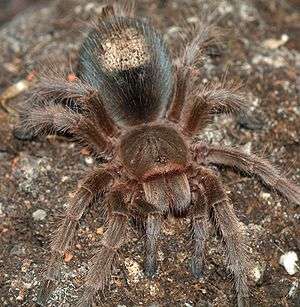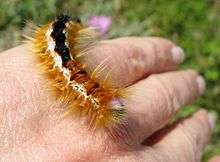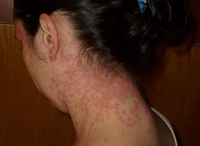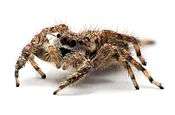Urticating hair
Urticating hairs or urticating bristles, i.e. irritating hairs, are one of the primary defense mechanisms used by numerous plants, almost all New World tarantulas, and various lepidopteran caterpillars. Urtica is Latin for "nettle" (stinging nettles are in the genus Urtica), and hairs that urticate are characteristic of this type of plant, and many other plants in several families. This term also refers to certain types of barbed hairs that cover the dorsal and posterior surface of a tarantula's or caterpillar's abdomen. Many tarantula species eject hairs from their abdomens, directing them toward potential attackers. These hairs can embed themselves in the other animal's skin or eyes, causing physical irritation, usually to great discomfort.

In plants

The most common form of urticating hairs in plants are typified by nettles, which possess sharp-pointed hollow hairs seated on a gland that secretes an acrid fluid. The points of these hairs usually break off in the wound, and the acrid fluid is pressed into it. Various plants unrelated to true nettles (Urtica species) possess similar defensive hairs, and the common names often reflect this (e.g. "bull nettle").
In Lepidoptera

Several lepidopteran families include species whose larvae bear urticating hairs. Families prominent in this respect include the following:[1][2][3][4]
- Arctiidae
- Anthelidae
- Bombycidae
- Erebidae
- Eupterotidae
- Lasiocampidae
- Limacodidae
- Lymantriidae
- Megalopygidae
- Noctuidae
- Notodontidae
- Nymphalidae
- Saturniidae
- Thaumetopoeidae
Adults of some species also have urticating scales, and some species shed some of their urticating hairs as defense for their pupae and eggs.
The urticating setae or spines can cause irritation when they break off and lodge in skin. In some species these structures are hollow and connected to venom-producing cells, functioning like a hypodermic needle. Generally most hairs are only irritating, but some are dangerous to the eyes and respiratory tract, and some can cause severe skin necrosis and shedding. Certain species of Lonomia in the family Saturniidae actually can inject venom that is life-threatening to humans.[5]
The stings are not part of a deliberate attack, but are mainly the result of brushing against the spines. However, many species whose larvae are armed with such hairs have behavioral patterns adapted to present the urticating hairs as a defensive threat and to inflict them on any perceived attackers. For example, many larvae in the family Lasiocampidae bear dense bands of short stinging hairs across their thoracic segments. The hairs are normally retracted into a shallow fold in the skin, but if the caterpillar is disturbed, it everts the folds and displays the hairs, which are usually of a contrasting color.
If seriously stimulated or gripped, lasiocampid larvae are likely to lash about, forcing the stinging hairs into any vulnerable organ within reach. Many other species of larvae lack any such localized concentrations of hairs and are armed more generally with urticating hairs; even so, they too will lash about frantically if disturbed, making them difficult to handle without suitable equipment. Toxins from the broken hairs may spill out, causing dermatitis on the surface of the skin.[6] For brown-tail moths (Euproctis chrysorrhoea) native to Europe and invasive in other parts of the world, hairs are shed or broken off during molts and can be wind-borne, so that direct contact with live or dead larvae is not required to trigger a rash.[7]
In spite of such defenses, some species of birds feed avidly on hairy caterpillars. Usually they grab them in their beaks and scrub them on the ground till the majority of the hairs have been stripped or damaged, but at least some species of cuckoos apparently collect the hairs in the digestive tract until they form pellets that can be regurgitated. Examples of avian predators other than cuckoos that feed on hairy caterpillars include at least tens of species from several continents.[8][9]
In tarantulas
Urticating hairs (setae) are found in about 90% of the species of tarantula (spiders of the family Theraphosidae) found in the New World. They are not found in tarantulas from other parts of the world.[10]
Development
Urticating hairs do not appear at birth but form with each consecutive molt, widening from molt to molt and outwardly presenting themselves around areas of more dark hairs on the upper back part of the abdomen of juveniles. In elder ages their coloration shifts to match the main tone of abdomen. Despite this shift, urticating hairs nonetheless retain unique characteristics that render them visually distinct from abdominal hairs, such as their tendency to cover only a portion instead of the entirety of the opisthosoma.
Types
There are seven different types of urticating hair known in tarantulas, varying in size and shape, particularly the distribution of barbs.[10]
- Type I (0.2–0.6 mm)
- Type II (0.5–1.5 mm)
- Type III (0.3–1.2 mm)
- Type IV (0.06–0.2 mm)
- Type V
- Type VI
- Type VII
Each type of urticating hair is believed to target different enemies. Defined targets for some hair types are unknown.
Type II is usually not kicked off by the tarantula, rather delivered by direct contact. However, there is at least one aviculariine species - Caribena versicolor - which can kick type II urticating hairs off of the abdomen, similarly to species from the subfamily Theraphosinae.[11] Tarantulas from the genera Avicularia, Pachistopelma and Iridopelma possess Type II hairs. (Toni Hoover, 1997)
Type III urticating hairs are most efficient for defense against vertebrates and invertebrates.
Types III and IV are the most irritating to mammalian predators.
Types particular to species
Not all urticating hair types are exhibited by each species of tarantula.
Type II urticating hairs can be found in the genera Avicularia, Iridopelma and Pachistopelma (subfamily Aviculariinae).
Type I and III urticating hairs are representative on a wide diversity of large bodied genera in the subfamily Theraphosinae Lasiodora and Acanthoscurria Nhandu spp., Megaphobema spp., Sericopelma spp., Eupalaestrus spp., Proshapalopus spp., Brachypelma spp., Cyrtopholis spp., and others, although some only have Type I in mature males. Unusually, Type III urticating hair is found alone on the species of Theraphosa spp., but these otherwise are similar to many species that also have Type I hairs.
Type III alone is found in many 'dwarf' new world genera "Hapalopus spp." etc.
Type IV is found in several South American genera Grammostola, "Euathlus" etc (exhibits types III and IV).
Type V urticating hair is typical of the species of genus Ephebopus. They are located on the pedipalps. They are much shorter and lighter in contrast with other types of urticating hair. These are easily thrown by the spider into the air (Marshal and Uetz, 1990).
Type VI urticating hair is found in the genus Hemirrhagus.[12]
Genera with the most urticating hairs are Lasiodora, Grammostola and Acanthoscurria.[13][14]
Defensive behavior
New World tarantulas will, at the moment of danger, turn toward the attacker and briskly rub their hind legs against the opisthosoma throwing the urticating hairs in the direction of the enemy. The cloud of small hairs will get into the mucous membrane of small mammals and cause edema, which can be fatal. The latest studies suggest these hairs cause both mechanical and chemical harm to the skin and membranes.
Reaction and the degree of irritation to a defensive urticating hair barrage can vary tremendously, based on the species in question. Some, such as those of the Chilean rose tarantula (Grammastola rosea) and the Pinktoe tarantula (Avicularia avicularia), are fairly mild and innocuous to humans. Others, such as those of the Brazilian giant white knee tarantula (Acanthoscurria geniculata), are moderately irritating. Still others, such as the Goliath Birdeater (Theraphosa blondi), are far more severe. These hairs can result in painful rashes, and have been likened to sharp shards of fiberglass.
After kicking urticating hairs, the Tarantula will have a bald spot on its abdominal region.
As territorial markings
Urticating hairs are not just thrown at an enemy as a first line defense, but are also used as an indication of territory. They can be found on and around the burrow entrance and in webbing for protection (for example, some subfamily Theraphosinae species include these hairs in cocoon silk).
Urticating hairs can also be found protecting tarantula egg sacs (Avicularia spp. and Theraphosa blondi respectively). This is thought to discourage fly larvae from consuming their eggs and young.
Human reactions to urticating hair contact

In humans, urticating hairs can cause allergic skin reactions which can manifest as inflammation, rash and/or itching. The reactions can last for several hours to weeks.[7][15] Ophthalmia nodosa, an irritation reaction, can result when the barbed hairs lodge in the cornea.[16] Handlers are advised to wear eye protection.[16]
Notes
- Matheson 1950
- Riley and Johannsen 1938
- Roth and Eisner 1962
- Wirtz 1984
- Pinto, Antônio F.M.; Berger, Markus; Reck, José, Jr.; Terra, Renata M.S.; Guimarães, Jorge A. Lonomia obliqua venom: In vivo effects and molecular aspects associated with the hemorrhagic syndrome. Toxicon. Volume 56, Issue 7, 15 December 2010, pages 1103–1112
- Stinging Caterpillars Found In Maryland University of Maryland Extension (2013).
- Browntail Moth Maine Department of Agriculture, Conservation and Forestry (accessed 2018).
- Ian Wyllie (1981). The Cuckoo. Universe Books. ISBN 978-0-87663-371-7.
- McCullough, Deborah G., Raffa Kenneth A., Chris Williamson R. Natural Enemies of Gypsy Moth: The Good Guys. Michigan State University Extension Bulletin E-2700, April 1999
- Bertani, Rogério & Guadanucci, José Paulo Leite (2013). "Morphology, evolution and usage of urticating setae by tarantulas (Araneae: Theraphosidae)". Zoologia (Curitiba). 30 (4): 403–418. doi:10.1590/S1984-46702013000400006.
- Bertani, R.; Boston, T.; Evenou, Y.; Guadanucci, J.P.L. (2003). "Release of urticating hairs by Avicularia versicolor (Walckenaer, 1837) (Araneae, Theraphosidae)". Bulletin of the British Arachnological Society. 12 (9): 395–398.
- F. Perez-Miles, 1998
- Vellard (1936)
- Buecherl (1951)
- Chao-Kai Hsu, Mark Ming-Long Hsur, Rick C. West, Yau-I Chu: Skin Injury Caused by Urticating Hair of Tarantula. Dermatologica Sinica. September 2007, S. 232-237
- Norris, J.H.; Carim, Z.I.; Morrell, A.J. (2010). "Spiderman's eye" (PDF). The Lancet. 375 (9708): 92. doi:10.1016/s0140-6736(09)61672-x. Archived from the original (PDF) on 25 December 2014. Retrieved 10 April 2013.
References
- Matheson, R. (1950). Medical Entomology (2nd ed.). Ithaca, New York: Comstock Publications.
- Riley, W.A.; Johannsen, O.A. (1938). Medical Entomology: a Survey of Insects and Allied Forms Which Affect the Health of Man and Animals. New York: McGraw-Hill.
- Roth, L.M.; Eisner, T. (1 January 1962). "Chemical Defenses of Arthropods" (PDF). Annual Review of Entomology. 7 (1): 107–136. doi:10.1146/annurev.en.07.010162.000543. Retrieved 10 April 2013.
- Wirtz, R.A. (1 January 1984). "Allergic and Toxic Reactions to Non-Stinging Arthropods". Annual Review of Entomology. 29 (1): 47–69. doi:10.1146/annurev.en.29.010184.000403. PMID 6362550.
External links
- Urticating Caterpillars chapter in United States Environmental Protection Agency and University of Florida/Institute of Food and Agricultural Sciences National Public Health Pesticide Applicator Training Manual
- Summary of Lancet article at Physorg.
